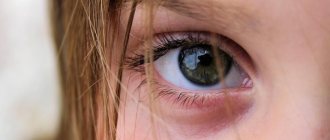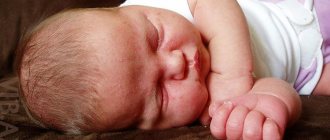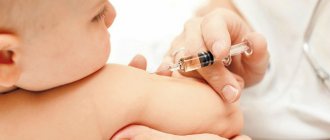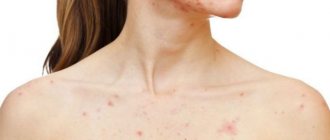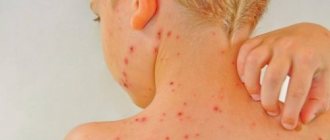Why does a child develop bruises on his legs and body for no reason - what could it be?
Children, due to increased activity and insufficient development of the vestibular system, often fall, resulting in bruises on their bodies. However, in some cases, parents may notice blue spots in their babies that form for no apparent reason. This phenomenon may indicate serious illness. If you notice bruises occurring for no reason on the child’s body, you must show him to the pediatrician. The doctor will prescribe the necessary examination and draw up a treatment plan.
Treatment of bruises on the legs of a child
Bruising on a child’s legs is treated with:
- Gel Troxevasin. The drug containing rutin strengthens blood vessels and helps the hematoma resolve faster. It is applied 1-2 times a day in a thin layer.
- Badyagi. The powder is diluted with water, the paste is applied to the bruise and kept for 10-15 minutes. The product is also used to remove stains, but children under 6 years old should not use it to avoid burns.
- Heparin ointment. The product relieves pain, improves tissue microcirculation, which ensures resorption of hematomas. It is applied 1-2 times a day to children over 2 years old; at an earlier age the ointment is not used.
- Balsam Rescuer for Children. It is more suitable for healing superficial wounds. But, thanks to the vitamins in the composition, it tones blood vessels, removes exudate from tissues, therefore it is also used for bruises.
- Cream Bruise-OFF. This natural-based remedy quickly resolves hematomas and relieves pain and swelling. But you need to be careful if your child is prone to allergies, since the cream contains leech extract.
- Gel Indovazin. The product relieves pain from a bruise and helps the blood to dissolve faster in the thickness of the skin. But children under 14 years old cannot use it. And patients older than this age should apply it 3-4 times a day.
If a child develops bruises on the body that are not from contusions, you need to look for the cause, and treatment in all cases is prescribed by specialists:
- for fragile vessels, one of the drugs may be Troxevasin or Troxerutin, ascorbic acid tablets;
- for lupus erythematosus - complex therapy, including antibiotics, hormonal drugs, cytostatics and NSAIDs;
- for leukemia, chemotherapy is prescribed, in difficult cases - a bone marrow transplant from a donor;
- in case of hemophilia, the condition is stabilized with the help of blood coagulation factors, the introduction of plasma, and the application of bandages;
- thrombocytopenia is treated taking into account the diagnosis that caused the phenomenon (glucocorticosteroids, angioprotective drugs, stimulators of platelet synthesis, vitamins, etc.);
- Henoch-Schönlein disease is treated with the use of antiplatelet agents, corticosteroids, and NSAIDs.
The mechanism of bruises and their types
When falls, bruises or other mechanical impacts occur, the integrity of small capillaries is disrupted, resulting in subcutaneous bleeding. When the blood clots accumulated under the skin decompose and the hemoglobin in it is completely destroyed, it changes color to purple or yellow-green. This is how bruises appear on the body. They can occur without any external influences. In this case, finding out the reasons for this phenomenon may take a lot of time.
In medicine, there are several types of bruises. These include:
- Hematoma. They present as painful hemorrhages into the subcutaneous layers, deep muscles and joints. This results in tissue damage, pathological fractures, joint dystrophy and muscle atrophy. This type is characterized by large affected areas.
- Microcirculatory. In this case, blue spots appear on the legs, arms, and mucous membranes. Bruises of this type can appear even with minor impact on areas of the body, for example, when rubbing the skin with a finger.
- Microcirculatory-hematoma. This form is mixed and includes a combination of the two previous varieties. In this case, the occurrence of a small number of extensive bruises with localization, as a rule, in the subcutaneous fatty tissue is characteristic.
- Vasculitic purpuric. These skin formations are inflammatory in nature and are accompanied by itchy rashes. After bruises of this type, pigmentation remains.
If a child's bruises begin to appear constantly, parents should monitor him. Having discovered that the cause of their occurrence is not injuries and bruises, it is worth excluding pathologies that may be associated with the formation of bruises on the baby’s arms or legs.
Time taken for a bruise to disappear in a healthy person
A bruise is a hemorrhage into the subcutaneous layers due to rupture of small capillaries. Bruises can occur due to a blow, trauma to the skin, after surgery, etc. In a healthy person, a bruise usually resolves within 7-14 days.
The following factors may influence the resorption of hematoma:
- Localization location. The farther the hematoma is from the heart, the longer it takes to heal.
- The age of the person. In old age, bruises take longer to disappear.
- Providing first aid. When cold is applied immediately after injury, the hematoma forms more slowly and goes away faster. Ice should not be applied directly to the skin; it should be wrapped in a towel to avoid frostbite of the tissues.
- Treatment being carried out. The use of ointments and gels can speed up the resorption of the hematoma.
The resorption of a bruise can be assessed by a change in its color. Initially, the hematoma is red or blue. Then, over time, the hemoglobin that is in the bruise begins to oxidize and breaks down into bilirubin and verdocromogen. These pigments are yellow and green, which explains the first greening and then yellowing of the bruise. Next, hemoglobin breakdown products are eliminated, and the skin acquires a natural color.
Why do bruises appear on the body?
Bruises on the arms, legs and other parts of the body are common in young children and older children. They often fall or get injured during active play. Parents should not ignore the bruises that constantly appear in children. They can signal the development of serious pathologies in the baby’s body.
Injuries and vitamin deficiencies
Children in the younger age group are still clumsy and may fall, open the door carelessly, or hit the corner of furniture. Older children get injured as a result of playing sports. Bruises often form on the face and other parts of the body of active fidgets after fights with peers. Boys are much more likely than girls to develop bruises or bruises.
Parents, after consulting with the pediatrician, need to select the optimal vitamin complex to eliminate the deficiency of nutrients necessary for the normal growth and development of the child.
In cases where bruises that appear on the baby’s body quickly disappear, parents have no reason to worry. However, if the blue spots do not disappear from the skin for a long time, and many new hematomas appear, you should immediately consult a doctor in order to find out why this is happening.
Bruises on a child’s legs as a sign of disease
Frequent bruises on the legs or knees may indicate certain diseases:
- Poor blood clotting. This disease is associated with the appearance of blue spots not only on the child’s legs, but also on other parts of the body. Pathology is very dangerous and often indicates the presence of malignant formations in the body.
- Disruption of internal organs. Diseases associated with the improper functioning of any organ provoke a decrease in tissue elasticity. For this reason, bruises often form in the back and other parts of the body.
- Hemorrhagic vasculitis. This pathology is characterized by a violation of the structural integrity of the walls of blood vessels, so they are destroyed, which leads to the formation of bruises.
Hemorrhagic vasculitis
Along with this, the use of blood-thinning drugs can lead to bruising in a child. These include almost all antipyretic and anti-inflammatory drugs. However, after stopping taking such medications, the resulting bruises disappear quite quickly.
What to look for the cause if the child has bruises all over his legs
If a child has bruises all over his legs, but he did not fight or hit himself, the cause may be a serious illness:
- Henoch-Schönlein disease and other autoimmune pathologies;
- damage to internal organs (liver, kidneys, gastrointestinal tract, etc.);
- hemophilia;
- thrombocytopenia.
The natural fragility of blood vessels can also lead to the appearance of this symptom. There is also a rare hereditary pathology - Randu-Osler-Weber disease, in which some vessels are devoid of muscular and epithelial membranes. For the first time it can appear at the age of 5-12 with the appearance of reddish spots and dots on the skin. Then nosebleeds appear, which are difficult to stop, and anemic signs.
Autoimmune pathology
Hemorrhagic vasculitis
Henoch-Schönlein disease, or hemorrhagic vasculitis, can cause a child to bruise frequently because the body itself destroys vascular cells. Due to the failure, an immune rejection reaction occurs. The body mistakenly perceives vascular cells as an enemy and produces antibodies. The capillary walls become thinner, break, and blood comes out. This is how hematomas form, primarily in the lower leg area. As the disease progresses, marks may appear on the thighs, or less often on the entire body.
There are other signs of an autoimmune disease:
- the spots are round, protrude slightly above the skin;
- they are small and very small;
- when you press on the skin, the bruises do not turn white;
- the child complains of pain in the joints;
- before the marks appear, abdominal pain and vomiting are bothersome;
- discomfort is felt in the kidney area, since sometimes the pathology affects them too.
Hemorrhagic vasculitis can develop soon after an infectious disease, as a consequence of allergies or vaccinations. Boys get it more often than girls. The risk is higher in children aged 4-12 years.
Among the autoimmune pathologies accompanied by causeless bruises, there is also lupus erythematosus. Its peculiarity is a low platelet volume in the blood. In pathology, connective tissue and blood vessels suffer. And the blood thins out, so reddish spots form on the legs.
Malfunction of internal organs
Markings on the legs in the form of hematomas can be the result of pathologies of internal organs:
- liver,
- kidney,
- stomach and intestines,
- heart and blood vessels,
- spleen.
In all cases, although in different ways, metabolic disorders occur, which negatively affects the condition of the vascular walls, blood composition, and nutrient absorption.
Bruises may appear after a sore throat has become chronic, poisoning, or as a sign of rheumatism. Each case has its own mechanism of formation. But all pathologies affect the composition of the blood and vascular permeability.
Fragility of vascular walls
A child’s blood vessels can be brittle by nature; nutritional habits also play a role here. If their walls are fragile, minor bruises can leave large hematomas. And without any influence, small bruises of a reddish or bluish color appear.
As the child grows up, fragility is also detected in larger vessels. Then the bruises become more extensive and appear more often. This problem must be dealt with like a disease, since in the future it can cause hemorrhage.
Hemophilia
Hemophilia is a disease in which blood clotting is slow. In most cases, it is hereditary and is transmitted through the maternal line to boys. These are type A and B pathologies; the only son of the last Russian emperor suffered from one of them. There is also hemophilia form C, which is transmitted to children of either sex through the mother or father.
As a result of a blood clotting disorder, the child experiences bleeding without noticeable external influence. Most often, this first appears when the baby begins to walk, and it becomes more difficult to protect him from contact with furniture and objects. Markings are found on the legs. But sometimes bruises appear in infancy and are visible all over the body.
Another sign of hemophilia is bleeding gums and nosebleeds that are disproportionate to the impact on these parts of the body. Children with this diagnosis are usually thin, weak, and have pale skin.
Thrombocytopenia
Thrombocytopenia is not a disease, but rather a symptom of a pathology or syndrome in which there is a lack of platelets in the blood. This leads to a decrease in fluid clotting. Hence the signs of the condition:
- the child develops many bruises on his legs;
- small hemorrhages are detected in the form of dots throughout the body;
- bleeding of gums and other mucous membranes increases.
When the skin is damaged, bleeding is more difficult to stop than in a healthy person.
Diagnostics
Identifying the factors that provoke the causeless formation of blue spots on the legs, arms and other parts of the child’s body primarily includes a general blood test. A coagulorogram is also mandatory. Based on its results, one can judge the operation of the coagulation system. If blood clotting is normal, the doctor will prescribe an examination of the liver and blood vessels. In the absence of pathologies on their part, the content of ascorbic acid is determined. To reassure worried parents, the doctor conducts examinations with detailed explanations of their results.
What to do if bruises do not resolve
If you notice that the mark from the hematoma does not resolve, you need to undergo an examination. Only a specialist will be able to determine the cause of the deviation based on diagnostics and tests. First of all, you will be prescribed a blood clotting test, because it is a violation of coagulation that most often causes bruises without injury. If pathologies are detected, you will be prescribed treatment that will strengthen the walls of blood vessels and speed up blood clotting. It is important not to carry out drug treatment on your own, as this can lead to the development of dangerous complications.
To make the hematoma resolve faster, you can use local medications. Bodyaga and troxevasin have proven themselves to be good for treating bruises. Ointments and gels based on them should be rubbed into the bruise several times a day.
Prevention measures
In order to prevent the appearance of bruises on the baby’s skin, parents must follow a number of rules. These include:
- nutritious and varied nutrition;
- monitoring the body's intake of sufficient amounts of essential vitamins;
- the child’s use of vitamin complexes when it is impossible to replenish the body’s reserves of useful substances from the foods consumed;
- avoiding long-term use of medications that negatively affect blood clotting;
- consultation with a pediatrician before using any medications.
In addition, it is necessary to take measures to strengthen the child’s body’s defenses. Such activities will allow you to resist various ailments.
Bumps and bruises
Consequences of serious blows
I was almost afraid to take my three-year-old to his annual checkup, says one mother of an active preschool-age child. He had so many bruises from top to bottom on his shins that it looked like we were beating him.
For children, bruises are an occupational disease. Children run, jump, climb, roll, ride bicycles... and fall, causing themselves a huge number of injuries. Jeffrey Vogel, a pediatrician in Fort Washington, Pa., and a staff physician at Chestnut Hill Hospital in Philadelphia, says bruises are so normal that if he sees a child without bruises on his legs, he wonders if the child's parents are too much. guard him.
Most bruises and contusions do not require a doctor's attention and can be successfully treated at home using the following simple methods.
Place ice on the injured area. If the skin isn't broken, ice it for at least five minutes, says Grace Caputo, MD, associate director of emergency medicine at Children's Hospital and assistant professor of pediatrics at Harvard Medical School, both in Boston. However, you should never apply ice directly to your skin; wrap the ice pack in a towel.
If the skin is broken, first clean the skin, cover the wound with a clean bandage and apply ice to the already covered wound. Apply ice to the injured area continuously after bruising occurs to reduce swelling. Most children only last 20 minutes, says Dr. Caputo. Apply ice repeatedly until the swelling begins to decrease.
Apply cold compresses . If the injury appears to be minor and the child refuses ice, use a cold compress instead of ice, Dr. Vogel advises. Simply soak a clean cloth in cold tap water, wring it out, and place it on the injured area. If the child refuses even this, do not insist.
Elevate the injured limb . If a bruised arm or leg swells after applying ice, elevate it with pillows, says Dr. Caputo. This will reduce swelling.
Switch to warm compresses . After 24-48 hours, it is time for warm compresses. Cold constricts blood vessels and helps stop bleeding more quickly, Dr. Vogel explains. Once the blood vessels have healed, you want the bruise to disappear. Heat dilates blood vessels, increasing blood flow, and the bruise disappears faster.
Soak a washcloth or towel in warm water and apply it to the bruise two or three times a day for five to ten minutes. Do this for two or three days, or until the bruise begins to disappear. Explain to your child that the change in color of a bruise—from red to purple to greenish-yellow—is a result of healing.
Kiss him and the child will feel better . I don't say this lightly, notes Dr. Joseph Hagan, a clinical assistant professor of pediatrics at the University of Vermont College of Medicine in Burlington and a pediatrician at South Burlington. A little compassion and support from parents will definitely have a positive impact. Some bruises, even if they don't look scary, can be quite painful.
Give your child pain medication. If your child complains of pain, you can give him an appropriate dose of children's paracetamol , says Dr Caputo. (Check the instructions for the dose appropriate for your child's age and weight. If your child is under two years old, consult your doctor.) However, for bruises to the abdomen and head, do not give your child any pain medication until seen by a doctor.
When to see a doctor
Some bruises require a doctor's examination before you begin treatment at home. And in very rare cases, bruises that spontaneously appear on the body indicate serious diseases such as leukemia.
Seek medical help if:
- injured eye or head;
- the head is hit above the ear, a fracture easily occurs in this place;
- the child has difficulty walking, talking or seeing, becomes drowsy, unresponsive to his surroundings, or has one pupil larger than the other as a result of a blow that caused a bruise;
- the joint swells, especially the elbow;
- bruises appear in unusual places, such as the back, calves, or the backs of the arms;
- a light blow leads to the formation of a large bruise;
- the blow was a blunt or hard object, such as a bicycle handlebar, of great force to the stomach;
- after the bruise appeared, the temperature rose;
- bruises appear for no obvious reason
Source: “Home Doctor for Children,” Advice from American Doctors, ed. Claflin Edward
Bruises from contusions
The appearance of bruises on the legs of children after bruises does not require medical intervention and can be successfully treated at home. When your child has a bruise, you should first apply ice or a cold compress to the affected area. Most often, bruises on children's legs, especially on the knees, are accompanied by abrasions. In such cases, you must first cover the wound with a clean bandage and apply cold to the already covered area. If your child is too sensitive to ice, you can soak a towel or napkin in cold water and apply it to the injured area. After a couple of days, warm compresses are applied. Heat dilates blood vessels, significantly increases blood flow, and as a result, the bruise quickly disappears. In the future, various ointments are used to resolve hematomas.
Thus, the occurrence of bruises in children on the knees or ankles after bruises is a common occurrence. It’s another matter when hematomas on children’s legs appear on their own. If parents notice the appearance of unexplained bruises on their child, they should be wary. It is necessary to consult a pediatrician to conduct certain tests. First of all, you need to get tested to determine your platelet count. The insufficient presence of these blood cells may be a consequence of impaired blood clotting.
What is a bruise?
A hematoma is an accumulation of blood in soft tissue cavities due to damage to blood vessels.
The severity of hematomas is determined by three degrees:
- The first is that the bruise appears within a day; when pressed, a slight pain is felt.
- Medium - the bruise appears after three hours, and damage to muscle tissue is characteristic. The pain is felt without pressing on the hematoma.
- Severe - a bruise with a tumor or only a tumor, occurs almost immediately after the injury. There is severe pain in the injured area.
Complications
Why is a hematoma dangerous in children?
- suppuration of hemorrhages;
- infection;
- sepsis;
- internal bleeding in the abdominal cavity;
- peritonitis.
To avoid negative consequences if a child receives an injury to internal organs or the head, it is necessary to immediately consult a doctor.
What can you do
If the hematoma is an ordinary bruise, then it can be completely cured on its own. If there are signs of deep tissue damage and possible complications, it is necessary to show the child to a doctor and undergo the necessary examination. If a hematoma appears on the baby’s body, the following measures should be taken to ensure its rapid resorption:
- create a state of complete rest for the damaged area in the first days after the injury;
- in case of a bruised limb, it is necessary to place it slightly above the body in a comfortable position;
- apply a compressive bandage to the site of the bruise to stop internal hemorrhage;
- apply cold to the injured area immediately after injury;
- apply wet cold compresses;
- you can use folk recipes and apply a washed and crushed leaf of plantain, yarrow or nettle to the hematoma;
- after two days, start applying heat to the bruise (the procedure helps speed up the resorption process);
- if the treatment process is delayed, you can take warm baths daily for 15 minutes; massage the damaged area with light movements;
- If there is a hematoma on the extremities, perform physical exercises to normalize blood circulation.
If the hematoma does not disappear for a long time or there is suspicion of damage to internal organs, it is necessary to urgently show the child to a doctor.
What can a doctor do?
Typically, in the case of complex hematomas in children, a doctor may resort to the following treatment methods:
- use of linen plaster;
- physiotherapeutic procedures;
- opening and drainage during suppuration;
- puncture and removal of tumor contents;
- surgery to remove the hematoma.
Causes of bruises
The most common origin of bruises is caused by bruises and falls. Infants are not immune from such cases.
If weak pressure or a slight blow to any object causes a hematoma, then this indicates a disease of the circulatory system. The walls of blood vessels and capillaries are so thin that at the slightest impact they burst, causing bleeding.
In children over one year of age, this is caused by an acute deficiency of vitamins, such as:
- Ascorbic acid (vitamin C). Without this vitamin, the walls of arteries, blood vessels and veins lose their elasticity.
- Vitamin K. Affects blood clotting in injuries.
- Rutin (vitamin P). Makes the effect of ascorbic acid more effective, and makes small capillaries strong and elastic. The body does not synthesize this vitamin on its own.
Including insufficient amounts of micro and macroelements:
- Calcium. Affects blood clotting.
- Selenium. Activates the immune system.
- Cobalt. Affects the process of cell renewal in the body. The problem may arise within two weeks after birth if the child is not given an injection with this vitamin.
The appearance of hematomas on the legs of children for no reason may indicate the presence of serious illnesses.
Bruises on the legs for no reason in teenagers and young children
Bruises on the legs for no reason in a teenager and young children can form due to vitamin deficiency and a lack of other substances necessary for the body.
The lower extremities suffer because their vessels bear a greater load than all other parts of the body. The problem is caused by a deficiency:
- Ascorbic acid. It is necessary for the strength and elasticity of blood vessels. In the absence of the required amount of substance, their walls are easily damaged. With a deficiency of ascorbic acid, the child often catches colds, and his skin may peel off.
- Vitamin K. The component ensures normal blood viscosity. If it is too liquid, it easily leaves the broken capillaries. Therefore, the child may experience nosebleeds, and any skin injuries take a long time to heal.
- Vitamin P. This substance promotes the absorption of ascorbic acid, that is, it also gives elasticity to blood vessels. But it itself is not produced by the body, it is only obtained from the outside. A deficiency may be indicated by frequent diarrhea, abdominal pain, increased skin sensitivity to the sun, and allergies.
- Calcium. The trace element ensures normal blood clotting. With its deficiency, the vascular walls weaken, and after damage they are poorly restored.
- Cobalt. The substance is involved in the absorption of iron, the formation of blood cells, that is, it is necessary to normalize the composition of the blood. And it also builds immunity.
- Selena. The component strengthens blood vessels and supports the body's defenses. Deficiency leads to weakening of capillary walls.
Children and teenagers are often capricious when it comes to food and agree to eat only what they want, which is not always healthy food. Deficiency can also be caused by diseases that interfere with the absorption of vitamins and microelements.
What to pay attention to
Not only bruises on the legs, but also the following manifestations may be a reason to consult a pediatrician:
- It is difficult for the child to move, he does not perceive others;
- light impact on the surface of the body leads to the appearance of an extensive hematoma;
- the temperature increased due to the bruise;
- bruises appear on their own.
It is necessary to observe and strictly follow all doctor's instructions. Do not delay and immediately begin treating diseases that cause hematomas on the legs of children.
What do bruises for no reason mean?
The appearance of bruises on the legs of children for no reason is an indicator of significant troubles with the condition of the blood and circulatory system. Lymph moves throughout the body from bottom to top. Because of this, the formation of petichiae and bruising primarily occurs on the lower extremities.
This picture may not only be due to thrombocytopenia with very low platelet presence. The reason may be:
- Liver diseases (icteric hepatitis, inflammation, acute poisoning, etc.);
- sepsis (general infection of the body), accompanied by a significant increase in temperature and fainting.
- In newborns, bruises on the legs for no reason may appear due to a lack of vitamin K. Petichiae and hematomas appear on the thighs, slightly below the buttocks. If hypovitaminosis is left untreated, bruises become more numerous, and they begin to appear on the buttocks and back.
Reasons for long healing
If the bruise does not go away within 20 days, this is a reason to consult a doctor. First you need to find out the cause of the hematoma. If it is a deep tissue injury, the bruise will be accompanied by pain and swelling. In this case, the hematoma may take longer to resolve. If the bruise does not go away for a long time, but the reason for its appearance is difficult to remember, and there is no swelling or signs of injury, this should alert you. There are several possible reasons why bruises do not go away for a long time, namely:
- Blood pathologies. There are a lot of blood diseases in which coagulation is impaired, which can result in sudden subcutaneous bleeding. The most common blood diseases include anemia, thrombocytopenia, hemophilia and leukemia.
- Metabolic disease. With deviations associated with metabolic disorders, a decrease in the restorative functions of the body occurs. As a result, bruises and any other injuries heal slowly. The cause of the deviation may be an unbalanced diet, chronic stress, or heavy physical work.
- Presence of infectious diseases. If a bruise appears during an illness with an increase in body temperature, the body will first fight the infection, so the bruise will resolve more slowly.
With blood pathologies, a long bruise is not the only symptom. Most often, in the presence of internal diseases, the patient experiences general malaise, his skin is pale, bleeding gums and frequent nosebleeds are observed. Also alarming manifestations of blood diseases include sudden weight loss, decreased immunity, enlarged lymph nodes, decreased performance, etc.
Treatment of hematomas
To achieve the desired success in treatment, you need to make a lot of effort. Not only the child, but also his parents must show patience. Therapy with medications is required. In complex forms of the disease, blood transfusions may be required. Both direct relatives and canned blood can become donors. Strict nutritional control is required. You should not eat anything fried. Proper nutrition determines the position of the child’s body for several years to come.
If bruises appear on the legs of children without obvious reasons, it is necessary to urgently seek medical help. Timely medical monitoring and treatment can minimize the adverse outcome of the disease.
First aid
Having discovered hematomas on the legs of children, you need to find out the cause of their origin. If the bruise is small and the skin is not damaged, then you can cool the damaged area for a short time, with a break of five minutes and then another cooling. This is necessary in order not to freeze the skin.
In the case where the hematoma is formed due to a wound with skin damage, the affected area must be disinfected using an antiseptic. Then apply cooling.
If a third-degree hematoma or its appearance has no reason, then you should urgently consult and be examined by a doctor.
ethnoscience
When bruises appear, you can use traditional medicine to get rid of them. However, this applies more to traumatic injuries; if bruises occur systematically for no apparent reason, a visit to a doctor is necessary. In nature there are a lot of plants that have a resolving effect, the most accessible of them are:
- Cabbage. To make the bruise resolve faster, you can make a compress of cabbage leaves for several hours, preferably at night. Before use, the cabbage leaf must be washed and slightly beaten with a meat mallet.
- Aloe. This plant has powerful regenerating properties. To treat hematomas, you need to peel the aloe leaf from the top layer and wipe the bruise with plant juice 3 times a day.
- Potato starch gruel. The starch needs to be diluted a little with cold water to make a paste. This mixture should be applied to the bruise 2-3 times a day. The result will be noticeable after 2 days of treatment. The bruise will completely resolve in 4-5 days.
- Iodine network. Iodine has a warming property, which helps increase blood circulation in the damaged area of the skin. An iodine mesh at night will promote faster resorption of the hematoma. It can be applied every other day.
Prevention
These measures will not ensure the child’s safety and will not prevent bruises on the legs. But they will significantly reduce the risk of their occurrence.
- If a child has allergies, protect him from interactions with allergens;
- provide the child with the necessary amount of minerals and vitamins;
- Walks in the fresh air are required;
- You need to get your child interested in sports and tell them about its benefits. At the same time, do not exceed physical activity for his age and build;
- Make sure that the child does not become hypothermic and protect him from infection. All this can lead to bruising;
- do not allow the child to become overweight. It can also cause hematomas. Weight should be within normal limits.
Parents should remember that their child needs to be examined regularly. And if bruises appear on children’s legs for no reason, consult a doctor, even if the child has not previously had troubles associated with blood and vascular diseases. First of all, this applies to cases when the site of the hematoma hurts, and the child has a fever.
Signs of abnormal bruising and bleeding
- Discrepancy between the strength of the physical factor and the damage. For example, a child slightly touched a chair with his foot and hit the table, followed by extensive bruises on his legs. Obviously, the cause is not proportional to the effect. In this case, blood coagulation disorders may be suspected.
- Frequent bruises that occur without a previous injury. It often happens that a child does not remember minor blows and falls. If this situation repeats, then you need to carefully observe the child and make sure whether he remembers or whether the injury actually did not occur. In the latter case, you need to see a doctor and get diagnosed.
- Bruises on the legs (and other parts of the body) that take a long time to resolve (say, more than a few weeks).
- Cases in the family, characterized by increased bleeding and the appearance of bruises for no reason or inadequate to the damaging factor. The fact is that most diseases of the blood coagulation system, such as von Willebrand disease and hemophilia, are genetic in nature and are inherited. Therefore, if similar cases have been observed in the family before, and now they are repeated in the child, then this is a reason for concern and consultation with a doctor.
- Prolonged, recurring nosebleeds (longer than 15 minutes).
- Prolonged bleeding after dental procedures and surgical interventions.
- Any signs of bruises in babies who have not yet begun to crawl.
- The appearance of bruises in unusual places that are rarely damaged by accident (and if this happens, the child will certainly remember about it): chest, back, neck, face, ears, etc.
- Long (more than 7 days) or heavy (within 3 days) menstruation during adolescence.
If you suspect the abnormal nature of the bruises, then pay attention to the following types of laboratory tests that will help confirm or refute the assumption.
